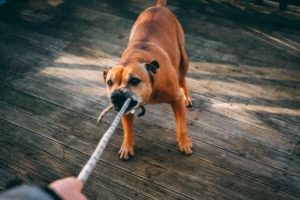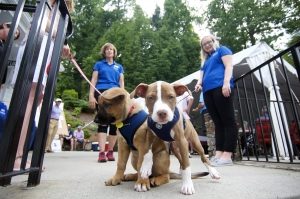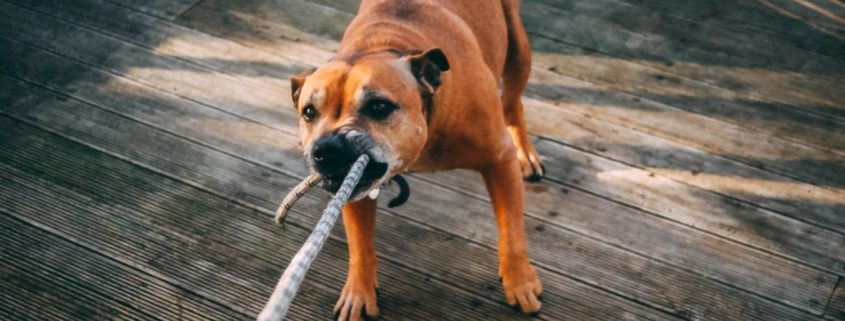Ask Crystal: All Chewed Up
Welcome to “Ask Crystal,” where you can ask your pet behavior questions! You can submit your question for Crystal at the bottom of the page!
Dear Crystal,
I have a 5-month old rescued puppy. I was wondering how you stop a puppy from chewing on you.
Sincerely,
All Chewed Up
Dear All,
My first tip is to get your hand out of the puppy’s mouth! Just kidding! I know puppies always seem to have their mouth on something. It is part of how they explore their world. Not dissimilar to human babies if you think about it. We do have to start teaching them to stop using their mouths on human skin by 5 months old.
Puppy mouthing is usually related to play behavior. If you watch dogs play with each other, they do tend to play with their mouths a lot, so it is all pretty natural. Mouthing can also become an attention seeking behavior if they learn that putting their mouth on you or grabbing your clothes gets your attention.
 The first technique to try is always going to be to redirect the puppy onto a toy and get them engaged with playing. Toys are going to be your best friend for a mouthy puppy. You don’t have to spend a lot of money either. You can look up ways to DIY tugs toys from old clothes and towels. I suggest that you carry a tug toy around with you at all time and possibly have toys stashed at various places around the house. If you are sitting down and your puppy stops mouthing on you, try to engage them with a tug toy or give them a chew toy. If your puppy likes to go after moving feet or pants legs, I would suggest that you make several latch toys that family members can drag around as they move through the house. You also want a large variety of chew toys so that the dog has a lot of appropriate things to chew on. I like to rotate my toys by picking up some periodically and putting them away. The dog will get excited as if it is a new toy when you give it back. It is a great way to keep interest in toys.
The first technique to try is always going to be to redirect the puppy onto a toy and get them engaged with playing. Toys are going to be your best friend for a mouthy puppy. You don’t have to spend a lot of money either. You can look up ways to DIY tugs toys from old clothes and towels. I suggest that you carry a tug toy around with you at all time and possibly have toys stashed at various places around the house. If you are sitting down and your puppy stops mouthing on you, try to engage them with a tug toy or give them a chew toy. If your puppy likes to go after moving feet or pants legs, I would suggest that you make several latch toys that family members can drag around as they move through the house. You also want a large variety of chew toys so that the dog has a lot of appropriate things to chew on. I like to rotate my toys by picking up some periodically and putting them away. The dog will get excited as if it is a new toy when you give it back. It is a great way to keep interest in toys.
Time outs can be very helpful because you are removing the thing that the dog wants which is you. It is critical that you are consistent in that everyone must follow the rules all of the time. This is not going to work if you allow the behavior some of the time. Some trainers advise to make a high-pitched yelp like a puppy would if they were bitten too hard. I personally haven’t had a lot of success with this technique, so I suggest a cue that means the dog is going to time out now. The second the dog puts their mouth on you, say “too bad” and walk the dog to the time out area. This area should be as boring as possible without access to anything to play with. Laundry rooms and bathrooms make great time out zones. You can also attach a leash to the door to limit the dog’s access to walk around. The time out should last no longer than 3 minutes but be long enough for the dog to calm down. You do not want to let the dog out while they are barking and throwing a fit or you will be reinforcing them for that behavior. You will need to get a lot of repetitions in for the dog to really start to get the idea. Training is all about repetition. Behavior takes time to change. There are no quick fixes.
For a time out to be effective, the dog needs to really enjoy being in the areas of the home that are not time out zones. If the dog is afraid of your screaming kids or is always getting yelled at, they may enjoy the quiet area and therefore it will not be punishing to them. In the beginning stages of training a puppy, when they are in “time in” you should be playing, training, giving them affection and attention. This is how we can ensure that social isolation will truly be punishing, and we can begin to train them to be polite household members.
If the puppy mouths when you are petting them, you can try to offer small bits of treats while you slowly and gently pet the dog. Petting often over stimulates puppies so you may have to limit the amount you pet them at this stage. I find petting while feeding treats or holds a chew toy for them usually allows me to pet them without mouthing.
 In my personal experience having another dog to play with is extremely helpful to curbing mouthing. If you have a friend with a friendly dog that you could do a lot of playgroups with that might help. If not, I would suggest a good dog daycare to take the dog to get some good play sessions in. I am not a fan of dog parks because of the amount of inappropriate play and bullying that goes on, so I suggest avoiding those.
In my personal experience having another dog to play with is extremely helpful to curbing mouthing. If you have a friend with a friendly dog that you could do a lot of playgroups with that might help. If not, I would suggest a good dog daycare to take the dog to get some good play sessions in. I am not a fan of dog parks because of the amount of inappropriate play and bullying that goes on, so I suggest avoiding those.
I hope it goes without saying but you should avoid playing with the dog’s mouth or encouraging roughhousing type of play. We don’t want to be teaching the dog that using their mouth to play is acceptable. Roughhousing type play can get dogs too aroused with can lead to increased mouthiness. The best type of play is hands off type play like fetching or flirt poles. Tug can be a good way to play if there are rules enforced. These rules include dropping the toy when requested and sitting when asked. Tug can be a high arousal game if there are no rules. With rules it can be a great way to exercise your dog and teach self-control.
It is really important to work on this problem now. We have seen dogs that 2-3 years old and are still mouthing people. It is really unpleasant, and it really hurts. If you are consistent with your training and are sure to be giving your dog enough exercise, this behavior will start to lessen until it eventually goes away. Be patient and hang in there!
Until next time,
Crystal







